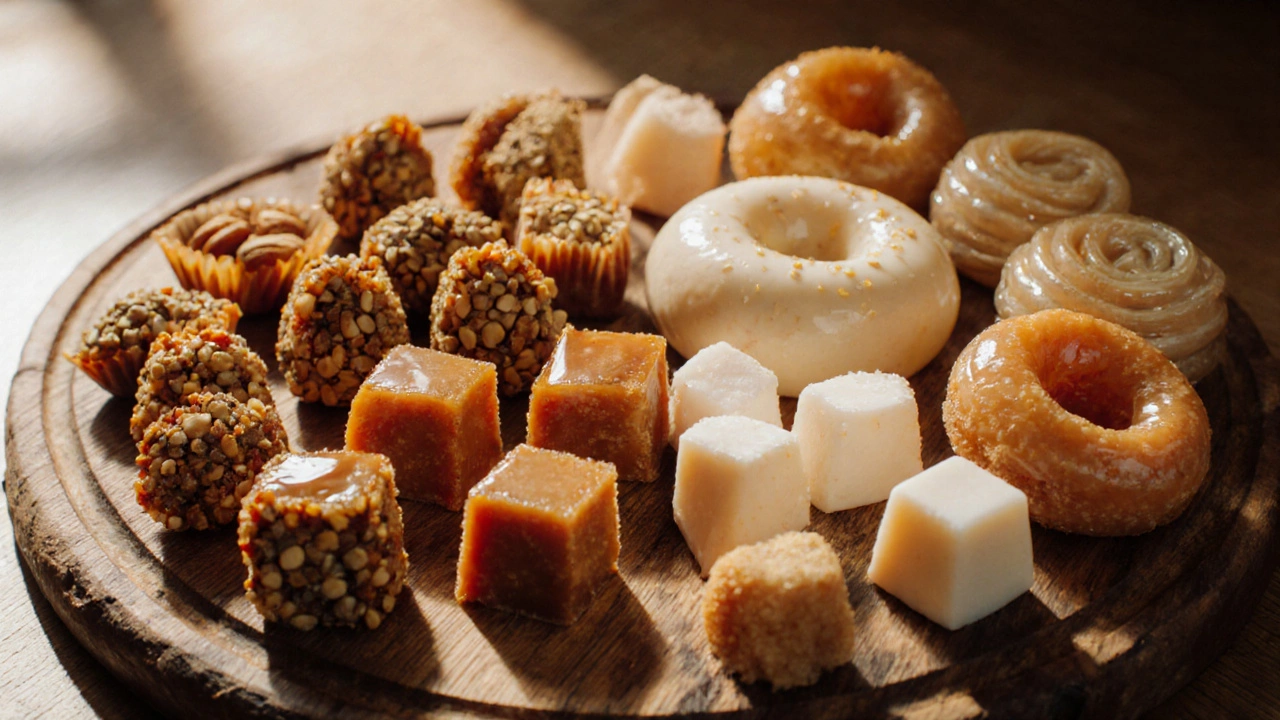
Vegan Indian Mithai Guide: Which Sweets Are Plant‑Based?
Discover which Indian mithai are truly vegan, how to spot hidden animal ingredients, and easy DIY swaps to enjoy classic sweets without dairy.
When you hear Indian vegan sweets, a range of classic Indian desserts made without any animal products. Also known as vegan Indian sweets, they blend centuries‑old flavors with modern plant‑based options, letting anyone enjoy the same festive sweetness without dairy or eggs.
These treats sit at the crossroads of several tasty worlds. Vegan desserts, desserts that use plant‑derived ingredients instead of animal ones rely on the same principles of balance and texture that traditional sweets do. Plant‑based ingredients, alternatives like coconut milk, almond flour, and soy yogurt replace dairy and eggs while keeping the rich mouthfeel. Meanwhile, Traditional Indian sweets, the historic confections such as gulab jamun, jalebi, and kheer provide the flavor blueprint—cardamom, saffron, rose water, and pistachios—that vegan versions mimic and honor.
Understanding the core attributes of Indian vegan sweets helps you create them confidently. The main attribute is dairy‑free: no milk, ghee, or paneer. The value is a dessert that stays true to Indian taste while being suitable for vegans, lactose‑intolerant folks, and anyone looking to cut animal products. Another key attribute is spice balance; the value comes from using cardamom, cinnamon, and nutmeg to evoke that familiar warmth. Finally, the texture attribute—soft, chewy, or syrupy—means you’ll often need a plant‑based thickener like agar‑agar or a cashew cream to achieve the right consistency.
Think of Indian vegan sweets as a special subset of Indian sweets vegan that requires a few extra steps. First, swap dairy with coconut cream or soy milk; this substitution changes the fat profile but retains richness. Second, replace ghee with vegetable oil or melted coconut butter, which brings a subtle flavor that works well with nutty spices. Third, use sugar syrups or jaggery for sweetness, as these solids dissolve easily in plant milks, giving you that glossy finish you see in classic gulab jamun.
These swaps are not just about removing animal products—they open up new flavor angles. Coconut milk adds a tropical note that pairs beautifully with mango or lychee in modern takes on traditional barfis. Almond flour lends a nutty depth to laddus, while tofu can mimic the crumbly texture of paneer in peda. By mixing and matching these alternatives, you create a dessert that feels familiar yet fresh.
When you plan a vegan Indian dessert menu, consider the occasion. For Diwali, bright, crunchy jalebi made with rice flour and sweetened with jaggery fits the festive vibe. For a summer get‑together, serve chilled coconut‑based kheer with fresh mango. For a wedding, present lavish vegan gulab jamun—soft, syrup‑soaked balls that melt in the mouth—using a blend of soy milk, flour, and a touch of rose water. Each dish shows how the central entity—Indian vegan sweets—can be adapted to different events while staying true to its roots.
Most people wonder whether they need special equipment. The answer: not really. A good whisk, a saucepan, and a silicone spatula are enough. For recipes that call for agar‑agar or gelatin substitutes, a small pot and a thermometer help you monitor the setting point. The key is patience; allowing syrups to reach the right temperature ensures that the final sweets have the correct texture, whether you’re making a soft barfi or a firm peda.
Another practical tip is to prep your spice mixes in bulk. Toast cardamom pods, cinnamon sticks, and clove buds, then grind them into a fine powder. Store in an airtight jar, and you’ll have the flavor base ready for any vegan sweet you decide to make. This habit reduces prep time and guarantees consistent taste across batches.
Beyond the kitchen, Indian vegan sweets have cultural relevance. They let vegans join in on traditional celebrations without feeling left out. They also support sustainable eating—plant‑based milks generally have a lower carbon footprint than dairy, and using locally sourced nuts and fruits further reduces environmental impact. In that sense, the central entity not only satisfies a sweet tooth but also aligns with ethical eating trends.
Our curated collection below showcases a mix of classic adaptations and creative twists. You’ll find step‑by‑step guides for vegan gulab jamun, dairy‑free kheer, and spice‑infused barfi, plus tips on storage, freezing, and serving. Whether you’re a beginner looking for an easy mango laddu or an experienced baker seeking a new take on jalebi, the posts ahead give you the tools to turn plant‑based ideas into delicious Indian desserts.
Ready to explore the world of Indian vegan sweets? Dive into the articles below and start creating desserts that celebrate flavor, tradition, and compassion.

Discover which Indian mithai are truly vegan, how to spot hidden animal ingredients, and easy DIY swaps to enjoy classic sweets without dairy.